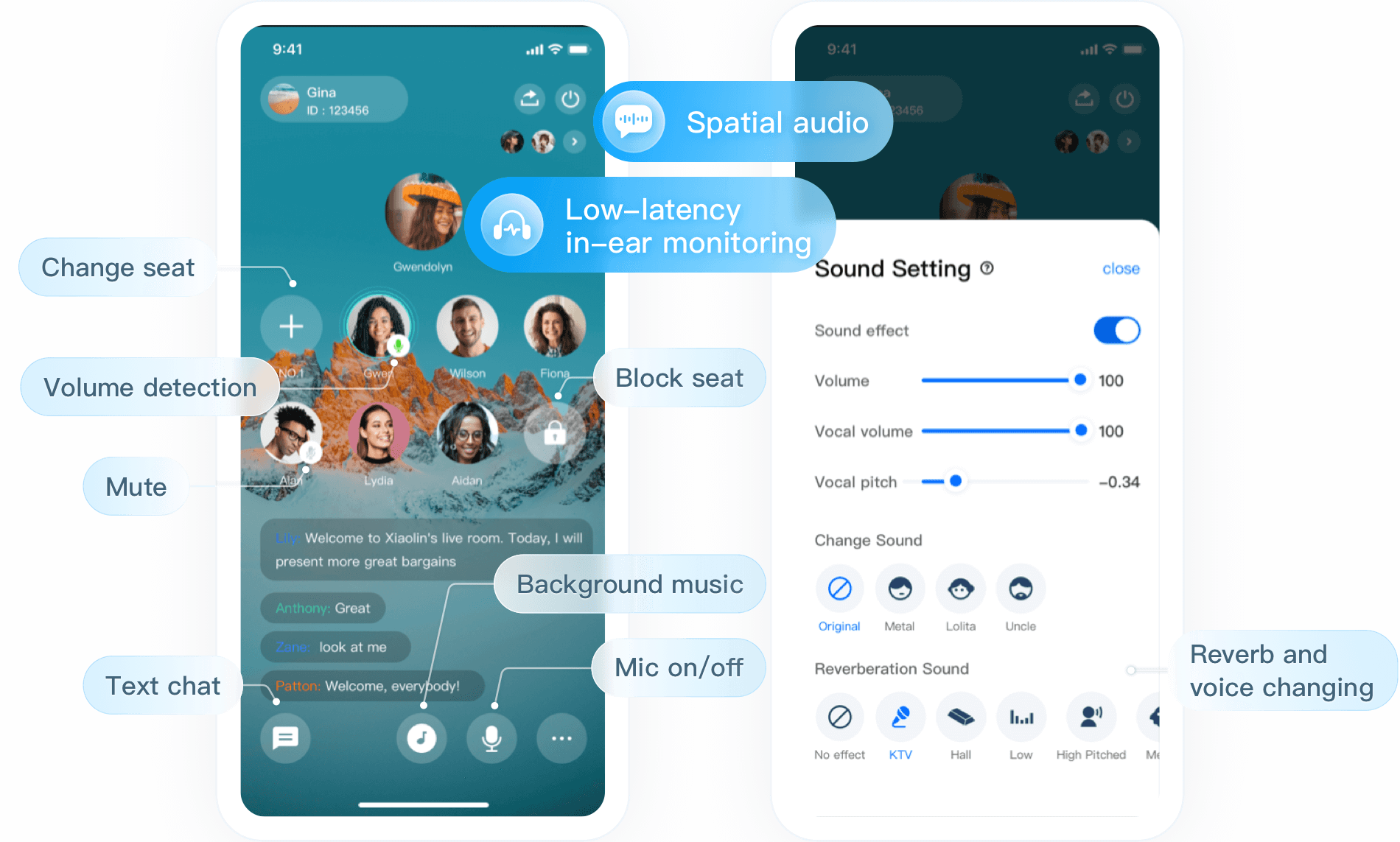Integrating TUIVoiceRoom (Android)
Overview
TUIVoiceRoom is an open-source audio/video UI component. After integrating it into your project, you can make your application support the group audio chat scenario simply by writing a few lines of code. It also supports the iOS platform. Its basic features are as shown below:Note
 |
Integration
Step 1. Download and import the TUIVoiceRoom component
Go to GitHub, clone or download the code, copy the
Android/Source directory to your project, and complete the following import operations:Add the code below in
setting.gradle:include ':Source'
Add dependencies on
Source to the build.gradle file in app:api project(':Source')
Add the TRTC SDK (
liteavSdk) and Chat SDK (imSdk) dependencies in build.gradle in the root directory:ext {liteavSdk = "com.tencent.liteav:LiteAVSDK_TRTC:latest.release"imSdk = "com.tencent.imsdk:imsdk-plus:latest.release"}
Step 2. Configure permission requests and obfuscation rules
Configure permission requests for your app in
AndroidManifest.xml. The SDKs need the following permissions (on Android 6.0 and later, the mic access must be requested at runtime):<uses-permission android:name="android.permission.INTERNET" /><uses-permission android:name="android.permission.ACCESS_NETWORK_STATE" /><uses-permission android:name="android.permission.RECORD_AUDIO" />
In the
proguard-rules.pro file, add the SDK classes to the "do not obfuscate" list.-keep class com.tencent.** { *;}
Step 3. Initialize and log in to the component
// 1. InitializeTRTCVoiceRoom mTRTCVoiceRoom = TRTCVoiceRoom.sharedInstance(this);mTRTCVoiceRoom.setDelegate(new TRTCVoiceRoomDelegate() {);// 2. Log inmTRTCVoiceRoom.login(SDKAppID, userId, userSig, new TRTCVoiceRoomCallback.ActionCallback() {@Overridepublic void onCallback(int code, String msg) {if (code == 0) {// Logged in}}});
Parameter description:
SDKAppID: The TRTC application ID. If you haven't activated TRTC, log in to the TRTC console, create a TRTC application, click Application Info, and select the Quick Start tab to view its 
SDKAppID.

Secretkey: The TRTC application key. Each secret key corresponds to a
SDKAppID. You can view your application’s secret key on the Application Management page of the TRTC console.userId: The ID of the current user, which is a string that can contain only letters (a-z and A-Z), digits (0-9), hyphens (-), and underscores (_). We recommend that you keep it consistent with your user account system.
userSig: The security protection signature calculated based on
SDKAppID, userId, and Secretkey. You can click here to directly generate a debugging userSig online. For more information, see UserSig.Step 4. Implement the audio chat room
1. The room owner creates an audio chat room through TRTCVoiceRoom#createRoom.
// 1. The room owner calls an API to create a roomint roomId = 12345; // Room IDfinal TRTCVoiceRoomDef.RoomParam roomParam = new TRTCVoiceRoomDef.RoomParam();roomParam.roomName = "Room name";roomParam.needRequest = false; // Whether the room owner’s permission is required for listeners to speakroomParam.seatCount = 7; // Number of room seats. In this example, the number is 7. 6 seats are available after you take one.roomParam.coverUrl = "URL of room cover image";mTRTCVoiceRoom.createRoom(roomId, roomParam, new TRTCVoiceRoomCallback.ActionCallback() {@Overridepublic void onCallback(int code, String msg) {if (code == 0) {// Room created successfully}}});
2. A listener enters the audio chat room through TRTCVoiceRoom#enterRoom.
// 1. A listener calls an API to enter the roommTRTCVoiceRoom.enterRoom(roomId, new TRTCVoiceRoomCallback.ActionCallback() {@Overridepublic void onCallback(int code, String msg) {if (code == 0) {// Entered room successfully}}});
3. A listener mics on through TRTCVoiceRoom#enterSeat.
// 1. A listener calls an API to mic onint seatIndex = 2; // Seat indexmTRTCVoiceRoom.enterSeat(seatIndex, new TRTCVoiceRoomCallback.ActionCallback() {@Overridepublic void onCallback(int code, String msg) {if (code == 0) {// Operation succeeded}}});// 2. The `onSeatListChange` callback is received, and the seat list is refreshed@Overridepublic void onSeatListChange(final List<TRTCVoiceRoomDef.SeatInfo> seatInfoList) {}
4. The room owner makes a listener a speaker through TRTCVoiceRoom#pickSeat.
// 1. The room owner makes a listener a speakerint seatIndex = 2; // Seat indexString userId = "123"; // The ID of the user who will become a speakermTRTCVoiceRoom.pickSeat(1, userId, new TRTCVoiceRoomCallback.ActionCallback() {@Overridepublic void onCallback(int code, String msg) {if (code == 0) {// Operation succeeded}}});// 2. The `onSeatListChange` callback is received, and the seat list is refreshed@Overridepublic void onSeatListChange(final List<TRTCVoiceRoomDef.SeatInfo> seatInfoList) {}
5. A listener requests to speak through TRTCVoiceRoom#sendInvitation.
// Listener// 1. A listener calls an API to request to speakString seatIndex = "1"; // Seat indexString userId = "123"; // User IDString inviteId = mTRTCVoiceRoom.sendInvitation("takeSeat", userId, seatIndex, null);// 2. Place the user in the seat after the invitation is accepted@Overridepublic void onInviteeAccepted(String id, String invitee) {if(id.equals(inviteId)) {mTRTCVoiceRoom.enterSeat(index, null);}}// Room owner// 1. The room owner receives the request@Overridepublic void onReceiveNewInvitation(final String id, String inviter, String cmd, final String content) {if (cmd.equals("takeSeat")) {// 2. The room owner accepts the requestmTRTCVoiceRoom.acceptInvitation(id, null);}}
6. The room owner invites a listener to speak through TRTCVoiceRoom#sendInvitation.
// Room owner// 1. The room owner calls an API to invite a listener to speakString seatIndex = "1"; // Seat indexString userId = "123"; // User IDString inviteId = mTRTCVoiceRoom.sendInvitation("pickSeat", userId, seatIndex, null);// 2. Place the user in the seat after the invitation is accepted@Overridepublic void onInviteeAccepted(String id, String invitee) {if(id.equals(inviteId)) {mTRTCVoiceRoom.pickSeat(index, null);}}// Listener// 1. The listener receives the invitation@Overridepublic void onReceiveNewInvitation(final String id, String inviter, String cmd, final String content) {if (cmd.equals("pickSeat")) {// 2. The listener accepts the invitationmTRTCVoiceRoom.acceptInvitation(id, null);}}
7. Implement text chat through TRTCVoiceRoom#sendRoomTextMsg.
// Sender: Sends a text chat messagemTRTCVoiceRoom.sendRoomTextMsg("Hello World!", null);// Receiver: Listens for text chat messagesmTRTCVoiceRoom.setDelegate(new TRTCVoiceRoomDelegate() {@Overridepublic void onRecvRoomTextMsg(String message, TRTCVoiceRoomDef.UserInfo userInfo) {Log.d(TAG, "Received a message from" + userInfo.userName + ": " + message);}});
8. Implement on-screen commenting through TRTCVoiceRoom#sendRoomCustomMsg.
// A sender can customize CMD to distinguish on-screen comments and likes.// For example, use "CMD_DANMU" to indicate on-screen comments and "CMD_LIKE" to indicate likes.mTRTCVoiceRoom.sendRoomCustomMsg("CMD_DANMU", "Hello world", null);mTRTCVoiceRoom.sendRoomCustomMsg("CMD_LIKE", "", null);// Receiver: Listens for custom messagesmTRTCVoiceRoom.setDelegate(new TRTCVoiceRoomDelegate() {@Overridepublic void onRecvRoomCustomMsg(String cmd, String message, TRTCVoiceRoomDef.UserInfo userInfo) {if ("CMD_DANMU".equals(cmd)) {// An on-screen comment is receivedLog.d(TAG, "Received an on-screen comment from" + userInfo.userName + ": " + message);} else if ("CMD_LIKE".equals(cmd)) {// A like is receivedLog.d(TAG, userInfo.userName + "liked you.");}}});
Suggestions and Feedback
If you have any suggestions or feedback, please contact colleenyu@tencent.com.